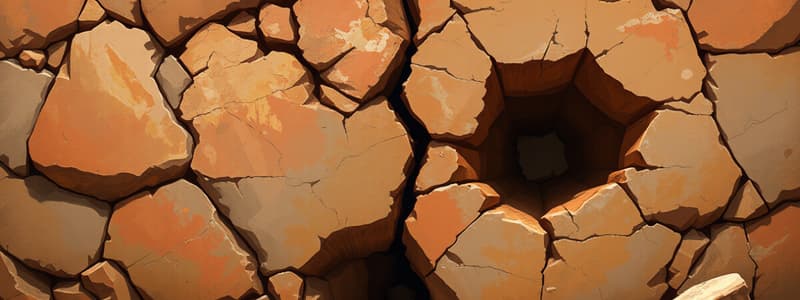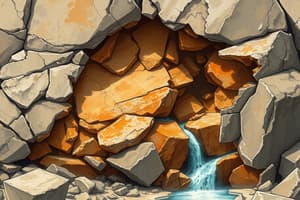Podcast
Questions and Answers
What best describes mechanical weathering?
What best describes mechanical weathering?
- Decomposition of materials influenced by water and oxygen.
- Breakdown of rocks through chemical reactions.
- Physical processes that reduce rocks to smaller pieces. (correct)
- Weathering caused solely by living organisms.
Which of the following is an example of frost weathering?
Which of the following is an example of frost weathering?
- Water freezing in cracks and expanding to widen them. (correct)
- Rocks expanding and contracting with temperature changes.
- Minerals crystallizing after water evaporates.
- The outer layer of rock peeling away due to reduced pressure.
What is a key factor affecting the rate of chemical weathering?
What is a key factor affecting the rate of chemical weathering?
- The presence of certain geological agents. (correct)
- The color of the rock.
- The age of the rock formation.
- The hardness of the rock alone.
Which process describes the phenomenon of crystals pushing into cracks in rock?
Which process describes the phenomenon of crystals pushing into cracks in rock?
How do warm and cold climates affect chemical weathering?
How do warm and cold climates affect chemical weathering?
What type of minerals in rocks tends to weather more quickly when exposed to environmental elements?
What type of minerals in rocks tends to weather more quickly when exposed to environmental elements?
Which of the following climatic conditions is likely to experience the highest rate of weathering?
Which of the following climatic conditions is likely to experience the highest rate of weathering?
What practice is recommended to reduce soil erosion in agricultural fields?
What practice is recommended to reduce soil erosion in agricultural fields?
What is the primary characteristic of mass wasting processes?
What is the primary characteristic of mass wasting processes?
Which type of mass wasting involves a rapid, destructive movement of rock and is often referred to as a rock avalanche?
Which type of mass wasting involves a rapid, destructive movement of rock and is often referred to as a rock avalanche?
What primarily causes runoff in the water cycle?
What primarily causes runoff in the water cycle?
What role does vegetation play in preventing mass wasting?
What role does vegetation play in preventing mass wasting?
Which phase change is responsible for water returning to the Earth's surface as precipitation?
Which phase change is responsible for water returning to the Earth's surface as precipitation?
How do infiltration and runoff differ in the water cycle?
How do infiltration and runoff differ in the water cycle?
Which type of mass wasting involves a coherent block sliding down a curved surface?
Which type of mass wasting involves a coherent block sliding down a curved surface?
What is a key factor influencing the occurrence of mass-wasting events?
What is a key factor influencing the occurrence of mass-wasting events?
What percentage of Earth's water is freshwater and what portion of that is accessible for use?
What percentage of Earth's water is freshwater and what portion of that is accessible for use?
How do normal faults form during tectonic activity?
How do normal faults form during tectonic activity?
What term describes the land area where precipitation drains into a common waterway?
What term describes the land area where precipitation drains into a common waterway?
What classification differentiates a reverse fault from a normal fault?
What classification differentiates a reverse fault from a normal fault?
What factor increases the rate of infiltration in soil?
What factor increases the rate of infiltration in soil?
What is the primary method by which water is returned to the atmosphere from the surface of the Earth?
What is the primary method by which water is returned to the atmosphere from the surface of the Earth?
Which type of geological fold has older rocks at its center?
Which type of geological fold has older rocks at its center?
What is an earthflow?
What is an earthflow?
What major geological event is directly associated with the formation of mountains?
What major geological event is directly associated with the formation of mountains?
Flashcards are hidden until you start studying
Study Notes
Weathering and Its Types
- Weathering breaks down rocks on Earth's surface, occurs via mechanical and chemical processes.
- Mechanical Weathering: Physical breakdown of rocks into smaller pieces, includes:
- Thermal Expansion: Rocks expand and contract with temperature changes.
- Frost Weathering (Ice Wedging): Water freezes in rock cracks, expanding and enlarging them.
- Exfoliation: Outer layers of rocks peel off as pressure decreases when rocks reach the surface.
- Abrasion: Rock fragments collide and wear against each other, driven by natural forces.
- Salt Crystal Growth: Evaporated water leaves behind salt crystals that expand in cracks, causing further weathering.
- Biological Weathering: Conducted by living organisms like plants, animals, fungi, contributing to mechanical and chemical weathering.
Chemical Weathering
- Involves transformative chemical processes such as acidification, hydrolysis, carbonation, and oxidation.
- Consists of two phases: decompose original materials and form new secondary materials.
- Rate of chemical weathering influenced by:
- Material hardness: Harder materials weather more slowly.
- Environmental conditions: Climate, moisture, and the presence of geological agents like water and oxygen enhance chemical reactions.
Soil Formation and Composition
- Soil is an essential medium comprising sediments, minerals, organic matter, gases, and microorganisms.
- Develops slowly through weathering, erosion, and deposition, often starting with pioneer species adding organic material.
- Soil types categorized by grain size (sand, silt, clay) and structure (granular, platy, columnar), with granular soil ideal for crops.
Soil Erosion Causes and Prevention
- Soil erosion occurs due to wind, water, or gravity, exacerbated by exposed or tilled land.
- Loss of topsoil leads to reduced nutrient quality and crop yields, alongside potential water pollution from runoff.
- USDA promotes erosion prevention practices such as shelterbelts, no-till farming, cover cropping, and contour farming, which stabilize soil.
Mass Wasting
- Defined as the downward movement of rock and soil due to gravity, influenced by water saturation and seismic activity.
- Types of mass wasting include slumps, rockslides, debris flows, and earthflows.
- Slumps: Slow downslope movement of semi-consolidated material.
- Rockslides: Rapid, destructive downward movement of rock material.
- Debris Flow: Highly saturated mass of soil and various rock sizes moving fluidly.
- Creep: Gradual downslope movement of soil, often observable in tree trunk bending.
Mass Wasting Triggers and Consequences
- Mass wasting caused by factors like increased rainfall, loss of vegetation, earthquakes, and steep slopes.
- Direct impacts include property damage and loss of life; indirect effects involve economic repercussions and reduced tourism.
Geological Structures and Processes
- Folds: Result from compressive stress, classified as anticlines (upward folds), synclines (downward folds), and monoclines (single limb).
- Faults: Fractures in the Earth's crust where movement occurs; classified into normal, reverse, and strike-slip faults based on their movement patterns.
Mountain Formation (Orogeny)
- Mountains, characterized by elevation and rock composition, arise from tectonic activities.
- Types include fold mountains (formed by plate collisions), dome mountains (magma pushing upward), and hotspot mountains (like those in Hawaii).
The Water Cycle
- The water cycle involves processes like evaporation, condensation, precipitation, runoff, and infiltration.
- Key phases include:
- Evaporation: Liquid water transforms into vapor.
- Condensation: Water vapor cools to form clouds.
- Precipitation: Water returns to the ground as rain, snow, or sleet.
- Infiltration involves water seeping into soil, critical for groundwater replenishment.
Global Water Distribution
- Water on Earth is predominantly salty, with only 3% as freshwater, most of which is in the form of glaciers and underground reserves.
- Surface water constitutes only a small portion of available freshwater.
Drainage Basins
- Drainage basins (or watersheds) direct precipitation and spring water to a common outlet, varying greatly in size.
- High ground surrounding these basins acts as divides, separating water flow into distinct drainage systems.### Drainage Basin Systems
- Drainage basins slope into river systems, collecting runoff from precipitation.
- Rivers begin with runoff which flows across surfaces, growing as they move downhill.
- First-order streams are the smallest, originating from small areas without tributaries.
- River systems evolve as first-order streams merge into second-order streams and larger.
- A drainage basin can comprise multiple smaller basins, all contributing water to a river.
- The Mississippi River drainage basin spans 31 U.S. states, draining into the Gulf of Mexico.
Streamflow Dynamics
- Streamflow describes water movement in a channel, influenced by water source, speed, and obstacles.
- Water can flow in two ways: laminar (quiet, smooth flow) or turbulent (chaotic, loud flow).
- Laminar flow features parallel layers with slow velocities and can be unidirectional, pulsatile, or oscillatory.
- Turbulent flow involves collisions with barriers, mixing water particles, and is typified by white-water rafting environments.
Erosion and Geological Processes
- Weathering breaks down large rocks into smaller fragments via wind, water, and glaciers.
- Erosion transports these fragments, with water erosion being faster compared to wind or glacial.
- Deposition involves the accumulation of eroded materials in new locations, altering landscapes.
- All three processes (weathering, erosion, and deposition) continuously shape landforms over time.
Geology Principle: Uniformitarianism
- Uniformitarianism posits the present explains the past, guiding geological event analysis.
- Four key principles help understand landform progression:
- Law of original horizontality
- Law of superposition
- Crosscutting relations
- Unconformities
Stream Valley Formation
- Stream valleys develop as water flows at the lowest terrain point, shaped by erosion.
- The aging process of valleys includes:
- Youth stage: steep gradient and V-shaped valley.
- Maturity stage: gentler gradient, U-shaped valley, and floodplain formation.
- Old age stage: wide, flat, slow-moving waterway with low gradient.
Base Level of Streams
- Base level marks the lowest erosion point for running water, including ultimate (sea level) and local (like lakes) types.
- Base level influences erosion and sediment deposition, affecting stream dynamics.
Bedrock and Bedrock Channels
- Bedrock is a solid rock foundation often covered by loose soil and sediments (alluvium).
- Erosion processes create bedrock channels through abrasion and plucking (quarrying) of rocks.
Alluvial Channels and Features
- Alluvial channels change shape based on water flow and sediment dynamics, leading to:
- Meandering streams: winding paths formed by point bar deposits.
- Braided streams: interwoven channels with sediment bars.
- Straight and sinuous channels: display linearity but vary in water flow due to sand bar deposition.
- Anastomosing channels: interconnected streams forming networks.
- Geological features from alluvial channels include oxbow lakes, flood plains, natural levees, and terraces.
Groundwater Dynamics
- Groundwater flows through natural fissures in the Earth, influenced by porosity, permeability, and gravity.
- Porosity determines soil's water retention ability, while permeability and gravity regulate flow speed.
Aquifers
- Aquifers are subsurface reservoirs of water, classified as confined (trapped by impermeable layers) or unconfined (free to flow).
- Natural springs form when aquifer water finds exit points, resulting in various surface water bodies.
- The quality of spring water varies based on environmental factors, impacting its suitability for consumption.
Well Types and Function
- Wells have been used for over 8,000 years to access underground water resources.
- Types of wells include:
- Dug wells: shallow, manually excavated.
- Driven wells: tubes propelled into the ground to reach aquifers.
- Drilled wells: deep wells created using machinery, often over 1,000 feet.
- Artesian wells utilize pressure to push water to the surface, minimizing the need for pumps.
Studying That Suits You
Use AI to generate personalized quizzes and flashcards to suit your learning preferences.




